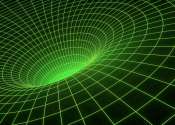Hubble detects smallest known dark matter clumps
When searching for dark matter, astronomers must go on a sort of "ghost hunt." That's because dark matter is an invisible substance that cannot be seen directly. Yet it makes up the bulk of the universe's mass and forms the ...









